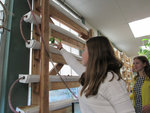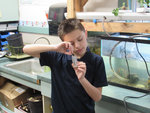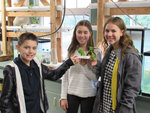


Twenty-four teams of seventh- and eighth-graders from Toledo Middle School are rallying to provide local low-income families with bags of fresh produce through their on-site aquaponics system as part of their bid to advance to the next round of Samsung’s Solve for Tomorrow Contest.
The competition will award winners with $15,000 prize packages.
Under the guidance of science teacher Sherrill Stead, students are maintaining and operating an existing aquaponics unit built five years ago to help grow a variety of native plants and edibles to help further Toledo Middle School’s community-based charity efforts.
Thus far, the school has been recognized along with five other Washington-based institutions among 300 finalists in the Samsung program, which encourages sixth through 12th grade students to solve real life issues in their communities by using classroom skills in science, technology, engineering and math, collectively referred to as STEM.
Leading the faction of enterprising students are eighth-graders Quyn Norberg and Whitney Olson and seventh-grader Zackaree Verhei, who described their aquaponics unit as a process that blends the cultivation of aquatic animals with hydroponics, a method of growing plants without soil.
“The fish eat and then waste comes out. The microbes will (then) convert the waste into stuff for plants to take in,” Verhei said.
The “stuff” he referred to is the end product of the fish waste, which the microbes will break down and turn into nutrients consumed by plants.
It’s this combination of fish, water and indoor lighting — allowing plants to eat, drink and grow — that allows the students to churn out grocery sacks of tomatoes, green onions, radishes, green beans and strawberries on a weekly and year-round basis.
When compared to more traditional ways of harvesting food crops, said Norberg, aquaponics enables vegetables and other consumables to grow at a faster rate. In fact, it was noted that through research and lighting, the students collaborating on the project have significantly accelerated growth times to where it now only requires two to three weeks to yield most of their produce.
“So, you could grow your plants, whether it’s ornamental or food crops, right in (an) aquarium with enough light on top of a rafting method (which employs styrofoam to keep radishes and other similar vegetables from drowning while their roots are being nourished in the water below) and not use soil, which is a great benefit for areas that have poor soil or gardening conditions outside that won’t allow for a traditional garden,” added Stead, who recently visited Jackson Hole, Wyoming, to examine vertical gardens inside a four-story building where hydroponics is used to grow lettuce, peas, beans and tomatoes at a commercial rate.
Currently, Toledo Middle School is finalizing its activity plan — outlining their strategy to improve the local community using STEM — which must be submitted by Dec. 4. If the Lewis County facility is chosen among 100 schools to advance to the second round, it will be presented with the opportunity of competing for $50,000 awarded to the 20 schools qualifying for the third round in late March.
“We have our fingers crossed,” Stead said when asked about her chances of going far in the contest. “We’re using science, technology, engineering and math. I can’t think of a better project for our community. This is something we need, and if we can get this to go, fantastic. If we get the ($50,000) prize, better yet. It will allow us to take our measurements and add really sophisticated lighting and a timing system, something that we’re not going to be able to do without those funds. But we’re going to go ahead and make it work anyway.”
The other part of the undertaking that isn’t going unnoticed by the school are the concepts of teamwork and responsibility that are being instilled in the participating middle schoolers who are diligently keeping track of their aquaponics operation to make sure it’s functioning at full capacity inside the school lab.
“I find it really enjoyable because I like doing things for other people, being helpful and giving back to the community. I realize that a lot of our school (consists of) low-income families and they need food. We’re giving back 37 or however many bags (weekly),” said Olson.
Norberg, on the other hand, highlighted how the whole experience has taught her how to become a better problem solver.
“We can have trial and error and not get all worried about if it’s going to work because we can all figure out different ways and research how we can make it work,” she said.